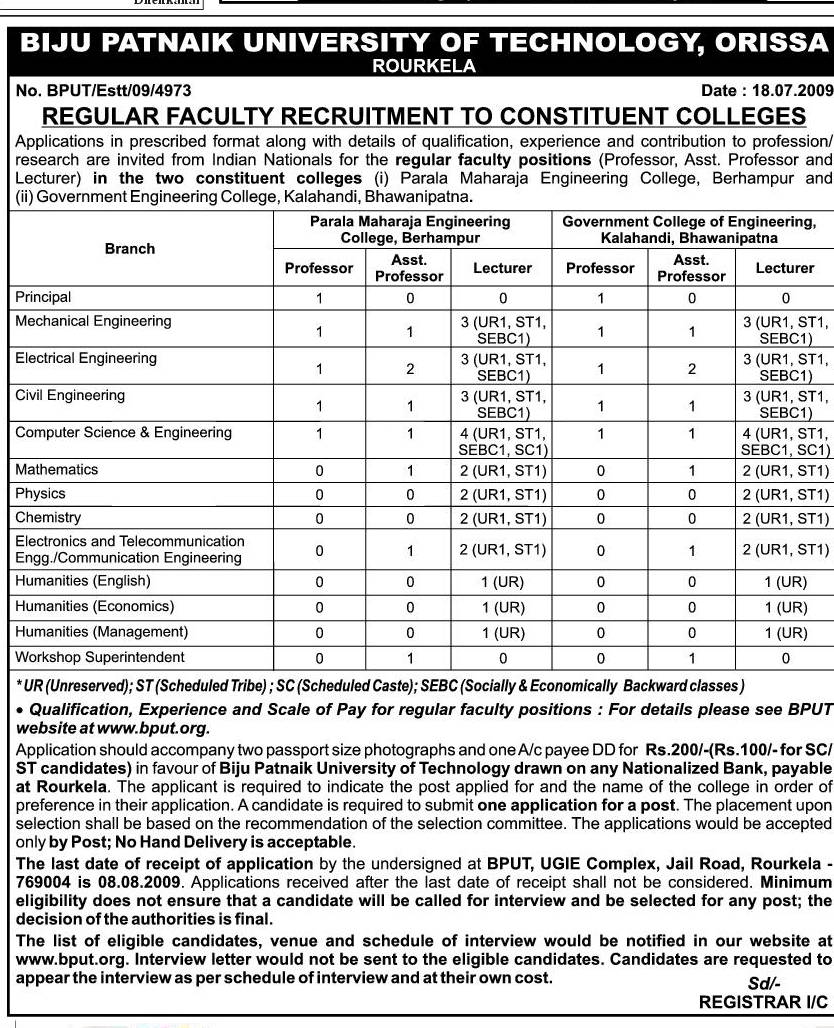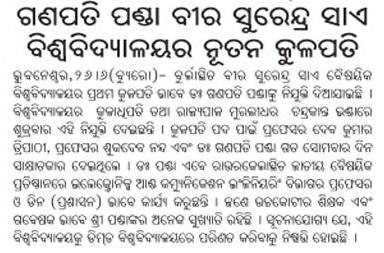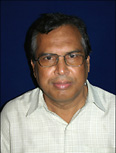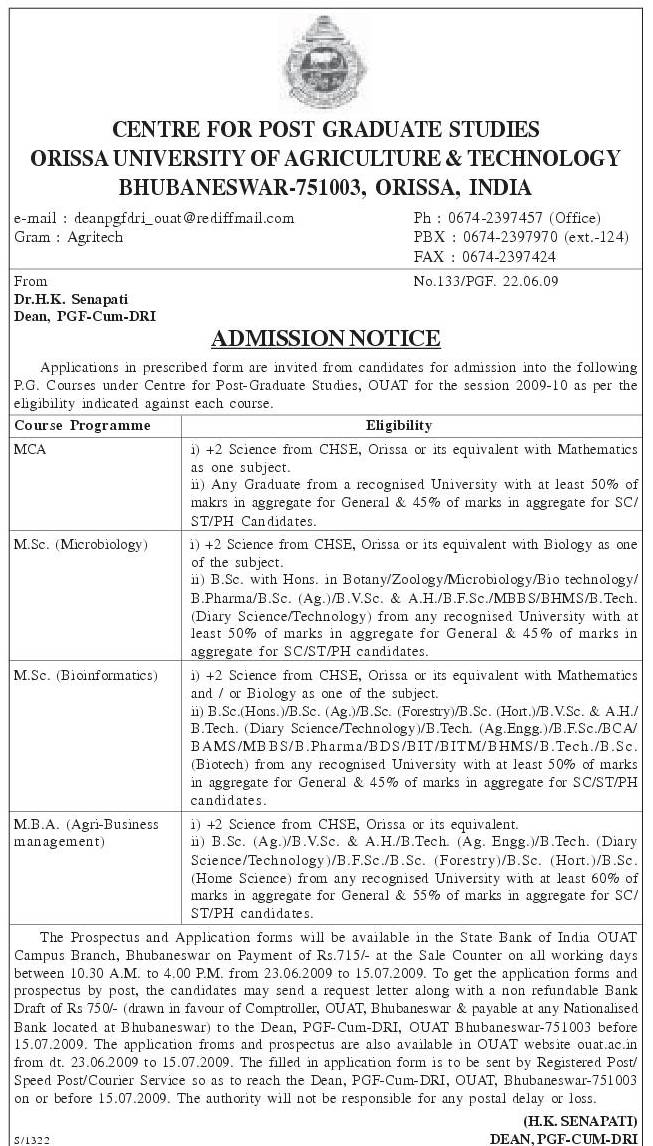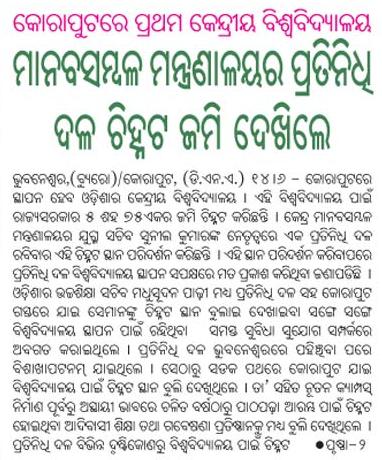Tathya.in, Pioneer and Samaja covered this.
The following response was received by Madhusmita Panda.
Government of India
Ministry of Human Resource Development
Department of Higher Education
****
New Delhi, the 10th July, 2009
To
Ms. Madhusmita Panda
C/o- Shri Bikram Kishore Panda,
E-8, UCO House, 1/1 Alipore Avenue,
Kolkata-7
Subject : Information sought for under Right to Information Act,2005.
Sir,
With reference to your application dated 27.5.2009, it is stated that any application under the section 6(1) of the Right to Information Act, 2005 is required to be accompanied by a fee of Rs.10 payable in cash or bank draft drawn in favour of Pay and Accounts Office of the concerned Ministry. Since the Indian Postal Orders enclosed with your application are payable to Central Public Information Officer, the same are not acceptable and, hence, are returned herewith. Accordingly, your application is not being treated as an application under section 6(1) of the Right to Information Act, 2005.
It may,however, be informed that on receipt of a letter from Shri Bikram Keshari Dev, Member of Parliament about locating the Central University of Orissa in Kalahandi district instead of Koraput district as recommended by the State Government, it had already been decided by this Ministry that the Indira Gandhi National Tribal University could consider establishment of one of its off-campuses in Kalahandi district during the 11th Plan Period,subject to availability of resources. No separate action was,therefore,called for on letter dated 17.8.2008 of Shri Digambara Patra on this issue.
Yours Faithfully.
R.D.Sahay,
Director & CPIO.
The Orissa government had earlier written about an IGNTU campus in Kandhamala. In light of the above, and the fact that IGNTU may have multiple campuses, the Orissa government should also push for a campus in Kalahandi.Considering the distance between Kalahandi and Kandhamala, the need of both places, and the name recognition (unfortunately in a negative sense) of both places it is quite possible that they can get multiple campuses.
July 19th, 2009
Following is an excerpt from a report in Times of India.
Central University, Koraput has requested the Centre to set up a medical college there in a bid to provide better medical facilities and educate local tribals.
"I have suggested the human resources ministry to build a medical college here because I feel the area needs it. But the final nod is yet to come from the ministry," CU vice chancellor Surabhi Banerjee said.
"Locals have to travel either to Vizag or to Berhampur to avail medical facilities and both these places are over 200 km away from here. The medical college will not only improve the quality of life of locals, but also provide scope for research in several diseases common here," Banerjee said. CU has also identified about 100 acre of land for the proposed medical college.
Banerjee said there are also plans to set up a nursing college. Several other need-based, region specific innovative courses will also be introduced. From the 2009-10 academic session, CU is initially beginning with five subjects. The school of language will offer English and Oriya while the school of social science will offer sociology, anthropology and tribal Studies and journalism and mass communication.
"We will take 30 students in each department. The faculty is being recruitment and we will begin classes from August. we will also appoint guest lecturers to take classes," the vice-chancellor said.
… CU also plans to introduce courses like maritime studies, disaster management, disaster management, environmental studies, rural development, and forestry under the choice based credit system. The university will initially function in the buildings of Silk Board and the local Jagannath temple until its own buildings are constructed.
Kudos to the VC for taking the above steps.
July 14th, 2009
Following is an excerpt from a report in Expressbuzz.com.
The International Institute of Information Technology (IIIT), Bhubaneswar, is all set to launch B Tech courses in several disciplines from the ensuing academic session.
The All India Council for Technical Education (AICTE) has granted its approval to the premier institute for intake of 240 students in the disciplines of Electronics and Communication Engineering, Electrical and Electronics Engineering, Computer Science Engineering and IT. Each discipline would have a seat strength of 60.
The students for the B Tech programme would be taken from the State JEE this year. Plans are to restrict intake from State JEE to between 50 and 60 percent and the rest from AIEE and IIT JEE in the subsequent years. Along with the B Tech courses, the institute will also include Ph.D programmes in its curriculum from this year.
… A proposal would be put up with the UGC for accordance of University status to it once it gets going in full strength. The institute, which is presently conducting M Tech courses in Computer Science and IT with 25 students each from the OCAC building, is expected to shift to its own campus at Gothapatna on the outskirts of the Capital in August this year. The campus would come up as a state-of-the-art facility to provide top standard atmosphere and education to the students. Spanning over 23 acres, the IIIT would then have around 2000 students, Prof Nayak said.
… work has started on establishing a second IIIT at Berhampur. The Government has allotted 100 acres for the proposed institute at Rangeilunda.
July 11th, 2009
Update: I talked to one of persons associated with AOLHET. He said that AOLHET is the US arm of Sri Sri University and its main goal is to raise $250 million (about Rs 1200 crores) for the Sri Sri University. He said many of the trustee members listed below have significant experience in fund raising for a university. With a budget like that, the freedom from government by virtue of being a private university, the world wide admiration and visibility of Sri Sri Ravishankar, and the world-wide network of Art of Living, this university could challenge the proposed National University in Bhubaneswar.
I stumbled across a new site for this at http://aolhet.com. AOLHET is Art of Living Health and Education Trust. It has more up-to-date information. From the pages there we have the following information.
Trustees:
Dr. Alfred Balitzer, former United States Special Ambassador to Brunei and Professor of American government, political philosophy and U.S.-Asia relations at Claremont McKenna College, is on the Board of Directors of the AOLHET
Mr. Raj Shah, Chairman and CEO of Capital Surini Group International, Inc. and Capital Technology Information Services, Inc., is on the Board of Directors of the AOLHET
Dr. Salim Aziz, a Cardiothoracic and Thoracic Surgeon and CEO and Medical Director of Capitol Cardiovascular and Thoracic Surgery Associates and Millennium Scan International, is on the Board of Directors of the AOLHET
Mr. Jeffrey Houk, Board Member of the Art of Living Foundations, is on the Board of Directors of the AOLHET
Dr. Dean Harmison, a Specialist in General Dentistry, is on the Board of Directors of the AOLHET
Dr. Raman Poola, a physician specializing in Gastroenterology and Internal Medicine, is on the Board of Directors of the AOLHET
Mr. Arif Diwan, President and Founder of WILLIGENT Corporation and Managing Director and General Partner at Chrimatos Investments, is on the Board of Directors of the AOLHET
Faculty/Staff
Dr. TN Seshan, former Chief Election Commissioner of India (1990 – 1996) is the President Designate of Sri Sri University
Dr. S Ramaratnam is Vice Chancellor Designate of Sri Sri University
Dr. NV Vasani, Vice Chancellor of Gujarat Nirma University is on the Advisory Board of Sri Sri University
Mr. S.B. Ganguly, Chairman of Exide Industries, is on the Advisory Board of Sri Sri University
Colleges, Academic Departments and Programs
• College of Management
Bachelor’s degree (2 years); students will focus in one or more of the following areas of study:
Marketing
Business Management
Human Resources
Banking and Finance
• College of Arts and Humanities
Bachelor’s degree (2 years); students will focus in one or more of the following areas of study:
Cultural Studies and Anthropology
Performing Arts
• College of Government
Bachelor’s degree (2 years) and Master’s degree (2 years)
• College of Mass Communication
Master’s degree (2 years)
• College of Social and Behavioral Sciences
Master’s degree (2 years)
• College of Biological and Environmental Sciences
Master’s degree (2 years); Students will focus in one or more of the following areas of study:
Sustainable Development
Pharmacology
Agriculture
Biotechnology
• College of Material and Transportation Sciences
Master’s degree (2 years); students will focus in one or more of the following areas of study:
Textile Sciences
Transportation Sciences
• College of Engineering
Master’s/Doctoral degree (4 years); Students will focus in one or more of the following areas of study:
Electronics and Telecommunications
Computer Sciences
Information Technology
Mechanical Engineering
Electrical Engineering
Instrumentation
Electronics and Electrical Engineering
Civil Engineering
• College of Ayurveda
Master’s/Doctoral degree (4 years)
• College of Vedic Sciences
Master’s/Doctoral degree (4 years)
• College of Mathematics and Physical Sciences
Master’s/Doctoral degree (4 years); Students will focus in one or more of the following areas of study:
Physical Sciences
Chemistry
Mathematics
• College of Medicine
Medical Doctoral degree (4 years)
• College of Law
Bachelor’s in Civil Law degree (5 years).
Sri Sri University will provide a unique educational experience that blends academic and personal development, which will nurture, educate, and empower students to become leaders in public service. A world-class academic institution, the University will feature multidisciplinary curricula to promote the pursuit of truth through educational and spiritual empowerment. Unparalleled didactics coupled with self-reflection will prepare students of all cultures and creeds for personal and professional excellence globally. A key objective of Sri Sri University is to foster scholarship and collegiality among its students, to inspire them to advance knowledge, to promote understanding, and to serve humanity.
The Art of Living Foundation and the Government of Orissa signed a Memorandum of Understanding on December 18, 2006 to establish a full-fledged multidisciplinary university near the state capital, Bhubaneswar within two to three years. The goal of the university would be to provide holistic education that is firmly embedded in Indian culture and ethos to the global leaders of tomorrow. Admission into the university will be based on merit alone, which will be assessed based on an entrance examination. Admission into the proposed varsity will be open to Indian as well as foreign nationals.
The proposed campus is being constructed in approximately 186 acres of land along the banks of the Mahanadi River in Naraj, about 20 miles from Bhubaneswar. The campus will include academic buildings, recreational facilities, meditation halls, and a sports complex. It will be designed to cater to the needs of 1,500 faculty members, an equal number of non-academic staff members, and 15,000 students. In 2007, the international consulting firm Deloitte Touche Tohmatsu was appointed to chart the strategic plans for Sri Sri University. Under the execution plan developed by Deloitte, Sri Sri University will establish the following colleges between 2009 and 2014:
Year 1: Management, Law, Government
Year 2: Mass Communication, Cultural Studies
Year 3: Engineering, Medicine
Year 4: Ayurveda, Vedic Sciences, Biotechnology
Year 5: Research Sciences
A Sri Sri University education will seek to inspire students to explore, create, serve and lead.
The goal of the Sri Sri University Teaching Hospital is to provide primary, preventive and educational healthcare. The Teaching Hospital will offer state-of-the-art, affordable medical care to communities in underserved areas by using an integrated approach that combines traditional health care and modern technology.
In the period between 2009 and 2014 the Art of Living Health and Education Trust aims to:
• Design and construct the Sri Sri University Teaching Hospital with specialized facilities on campus;
• Build 25 primary care satellite clinics in locations determined by a feasibility study, to be conducted in 2008-2009;
• Offer telemedicine services in primary care clinics with the capability to transfer patients with specialized medical needs to appropriately staffed and equipped clinics;
• Emphasize community-driven development through the International Association for Human Values’ 5H program [Health,Hygiene, Homes, Harmony in Diversity, Human Values]; and
• Develop a replication strategy using the design, construction, and operations of the Sri Sri University Teaching Hospital
as a prototype, in collaboration with other NGOs and charitable organizations, to extend the His Holiness Sri Sri Ravi Shankar’s vision of affordable primary, preventive and educational healthcare to other parts of the world.
Sri Sri University: Key Milestones:
• December 2006 – Memorandum of Understanding signed with State Government of Orissa to establish Sri Sri University
• January 2007 – University President Designate Mr. T.N. Seshan (Former Chief Election Commissioner) contracts Deloitte to chart strategic plans for University
• June 2007 – Governing board appointed and faculty recruitment launched
• November 2007 – Hong Kong architectural firm begins blueprint for environmentally friendly campus
• February 2008 – Orissa State Cabinet approves status as an Autonomous Educational Institution
Campus
”Home to more than 15,000 students and 1,500 academic faculty from around the world, Sri Sri University campus will be located less than 15 miles from Bhubaneswar, the capital of Orissa.
June 24th, 2009
Update: I am now told that the location is two km after CISF Mundali, towards Banki on the Cuttack-Banki road. The postal location is Mouza Banara, Tahasil Dumpada, District Cuttack. From Chandni Chowk, Cuttack it is 13 km. And from Oberoi Hotel, BBSR, it is 29 km.
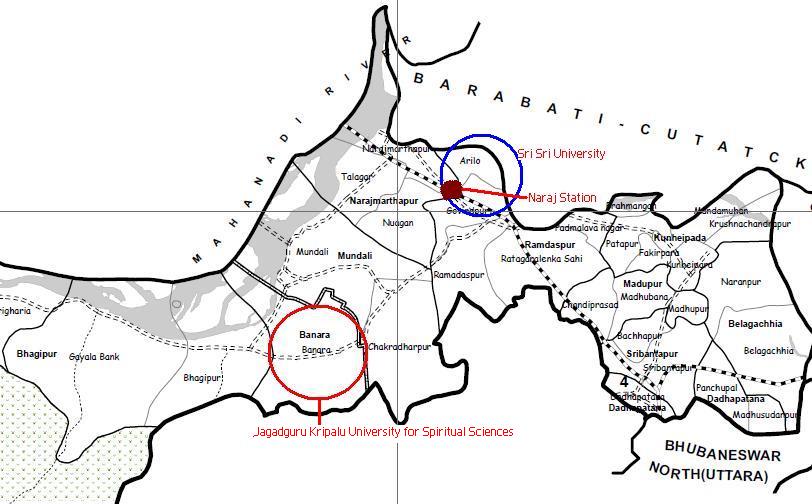
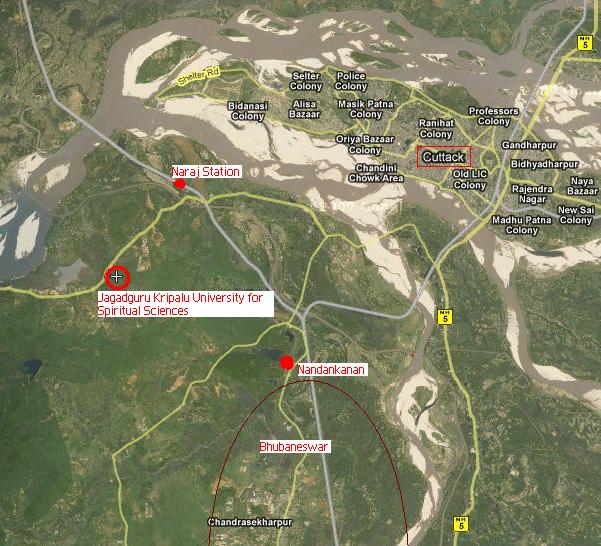
It now has its own web page. The web page has some nice drawings and overview of the university. We copy them here.

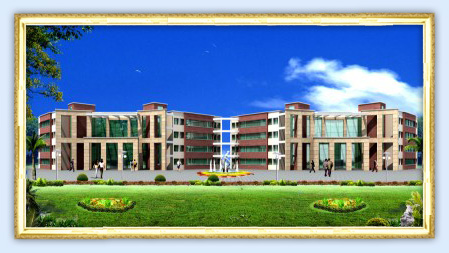
Introduction
A unique University that will train highly qualified Spiritual and Yog teachers for spreading the true and ancient science of "Yog" around the world will be built in the state of Orissa. The project will be a part of a spiritual community that will include a Gurukul, a Yog & Naturopathy Health Care Center, a Yogashram, a Charitable Hospital, and Organic cultivation farms.
The proposed university will be developed at Banki, near Cuttack, Orissa, in multiple stages. In the first stage, 110 acres of land has been finalised, and a Memorandum of Understanding (MoU) has been signed by the Trust and the Government of Orissa.
Objectives of the Proposed University

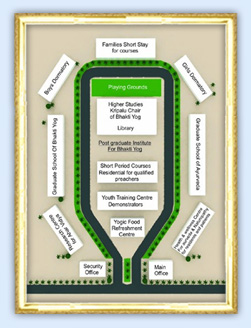
-
To Prepare Qualified teachers, who can then go to schools, colleges and industrial houses to teach the sciences of Spirituality, Yog and Mind management. At present, everyone realizes the imbalance in the education system, due to lack of spiritual education.
-
Introduction of moral education in all educational institutions. The creation of a qualified class of spiritual teachers will enable the introduction of spiritual education in society.
-
To give the spiritually-minded youth a chance to make a career in spirituality, by enabling them to earn a degree, and utilize it for teaching jobs.
-
To enable character building through higher education.
-
To reinforce ethics and morals so that the students may pass these on to the society at large.
-
For the upliftment of the underprivileged segments of society, free education and financial support will be given to 25 percent students from such segments of society.
-
The Proposed University will set a role model for the Universities of the country, in building the moral character of the people.
Courses Offered at the Proposed University
-
Bachelors and Masters in Yogic Sciences.
-
Bachelors and Masters in Vedic Sciences.
-
Teachers, Professors and Principals re-orientation programmes, with special emphasis on Morals and Ethics.
-
Bachelors and Masters in Naturopathy.
-
Bachelors and Masters in Bhakti Yog, in accordance with the philosophy of Jagadguru Shree Kripaluji Maharaj.
-
Research work – Doctorate – in Naturopathy, Vedic Sciences, Bhakti and Yogic Sciences.
-
One year diploma courses in all the above.
-
One month introductory courses in all the above.
-
One month Yog instructors course.
-
Karm-kand training courses for priests for temples in India and abroad.
-
Orientation programmes for Doctors in Yog Therapy.
Secular Courses- The students will also get an opportunity to do non-spiritual courses that offer the maximum job opportunities in the modern world, such as Information Technology and Business Management. This will enable them to get excellent careers in secular fields, if they so desire.
Related Projects:
Yoga Therapy and Naturopathy Healthcare Centre. It will attract outdoor patients from nearby towns and also neighboring villages. Also, indoor patients desirous of benefiting from yog therapy.
Gurukul. Will train children from childhood in the life of purity, charity, austerity, and spiritual knowledge.
Yogashram. Yoga shibirs will be conducted for the general public, for members, and for industrial houses. Such shibirs will be of 3 days duration, one week duration, two weeks duration and four weeks duration.
Old-age home. Devotionally minded people, who are leading a retired life, will be invited to come and stay in a spiritual environment. They will also be given an opportunity to lend voluntary seva in the above projects, and will form the manpower base for the project.
Hospital. The villagers of the nearby Banara village have demanded a hospital for them. Such a hospital, equipped with modern facilities will be built, to provide medical aid to everyone residing within 10 kilometers of the ashram.
June 19th, 2009
Update on 27th April 2011: The Central University location has been changed to Bander Sindri near Ajmer and only 80 kms from Jaipur. The Innovation University (previsouly referred to as National University) aiming for world class is now pushed for Jaipur. [Times of India]
The panel set up by the CM of Rajsthan has picked the following places to recommend to the central government for the various national institutes and universities coming up in Rajasthan. (From a Times of India report and another Times of India report)
- IIT : Jodhpur
- IIM: Udaipur
- National University aiming for world-class: Ajmer
- Central university: Bikaner.
The committee also recommended:
- a "futuristic" heritage conservation and museology centre in Jaipur
- an institute of Food Technology in Hadoti region of Kota
Currently the following national institutions exisit or are being made in the following places in Rajasthan:
- NIT: Jaipur
- LNMIT (private but top-notch): Jaipur
- National law School: Jodhpur
- AIIMS-like institution (being made): Jodhpur
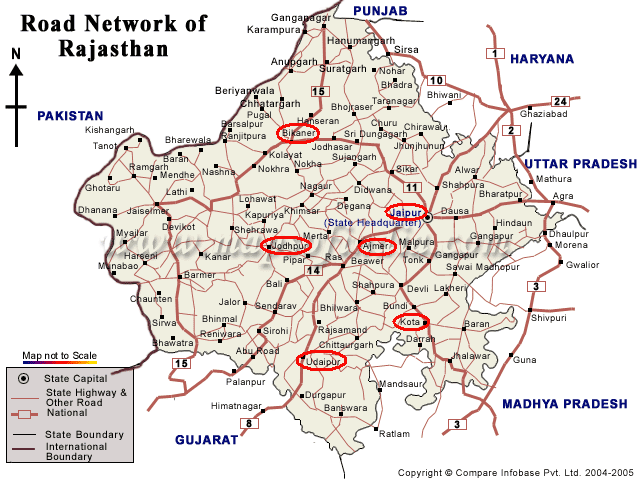
The institutions are nicely distributed between various cities of Rajsthan, although people of Jaipur and Kota are not happy. The population of these locations are:
- Jaipur (World Gazetteer 2009): 3.1 million (has inetrnational air connectivity)
- Jodhpur (World Gazetteer 2009): 988K – (332 kms from Jaipur; has air connectivity)
- Udaipur (World Gazetteer 2009): 457K – (400 kms from Jaipur; has air connectivity)
- Ajmer (World Gazetteer 2009): 604.7K – (131 kms from Jaipur)
- Bikaner (World Gazetteer 2009): 624.6K – (321 kms from Jaipur)
- Kota (World Gazetteer 2009): 823 K (242 kms from Jaipur)
In contrast in Orissa the distribution of national institutions are more Bhubaneswar centric. Following is the status:
- IIT: Bhubaneswar
- NISER: Bhubaneswar
- AIIMS-like (being made) : Bhubaneswar
- National Law University: Cuttack (part of Bhubaneswar metroplex)
- IIIT (state-funded) : Bhubaneswar
- National University aiming to be world class: Bhubaneswar
- Vedanta University (private): Puri
- NIT: Rourkela
- Central University: Koraput
- IIIT (centrally funded): state wants it in Berhampur; center has identified as Bhubaneswar
Unfortunately, one of the reason given behind the above selection is the lack of connectivity and the size of places. Following is some information on that.
- Bhubaneswar (World Gazetteer 2009): 1.67 million (has airport but no inetrnational connectivity)
- Rourkela (World Gazetteer 2009): 551 K (no air connections) – 334 kms from Bhubaneswar
- Berhampur (World Gazetteer 2009): 403 K (no air connections) – 160 kms from Bhubaneswar
- Koraput-Jeypore-Sunabeda: 200K+ (no air connections) – 499 kms from bhubaneswar
- Puri (World Gazetteer 2009): 185K – 60 kms from Bhubaneswar
- Sambalpur (World Gazetteer 2009): 258 K (no air connections) – 321 kms from Bhubaneswar
- Jharsuguda-Belpahar-Brajarajnagar: 200 K (no air connections) – 374 kms from Bhubaneswar; 50 kms from Sambalpur
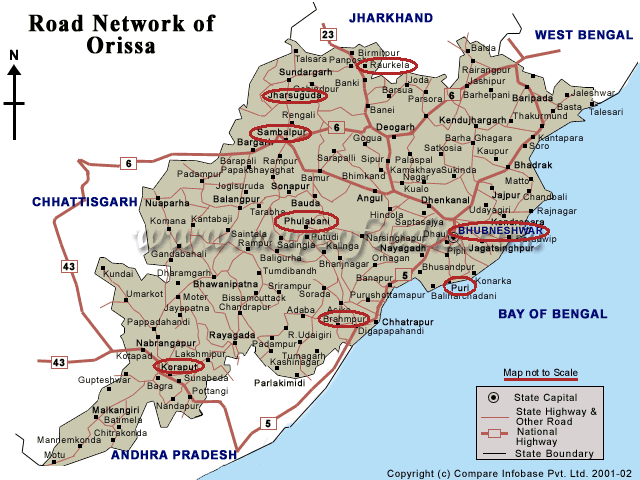
For the future, following are some of the steps that Orissa government needs to urgently take regarding developing more larger urban areas and having the national institutions more evenly distributed:
- Make sure the centrally funded IIIT is established in Berhampur
- Establish functioing airports in Jharsuguda, Rourkela and Koraput at the earliest
- Push for international flights to Bhubaneswar
- Push for upgradation of UCE Burla (Sambalpur area) to an IIEST (Indian Institute of Engineering Science & Technology)
- Push for the establishment of a branch of IGNTU (Indira Gandhi National Tribal University) in Phulbani
- Push for the establishment of IIM outside of the Bhubaneswar area
- Push for the establishment of a centrally funded KBK Inst of Engineering and Technology (along the lines of SLIET and ABAGKIET) in Kalahandi or Balangir.
- Push for upgrading another medical college (Berhampur or Sambalpur) to AIIMS level.
- Push for establishing NID in a location outside of Bhubaneswar
- Push for establishing NIPER in a location outside of Bhubaneswar
- Push for a BITS Pilani campus in a location outside of Bhubaneswar
June 12th, 2009
As per its web page, currently the KIIT group has the following institutions:
In 2009 it is starting four new schools:
- Mass communication
- Design
- Film studies
- Sculpture
In addition KISS (Kalinga Institute of Social Sciences) plans to offer Mastesr program in Physics, Chemistry, Mathematics, Botany, Zoology, Political Science, Philosophy, Economics, History, Tribal study, Anthropology, Accountancy, English, Oriya, and Sociology. the following ad for admission to KISS suggests that it will soon be a university on its own.
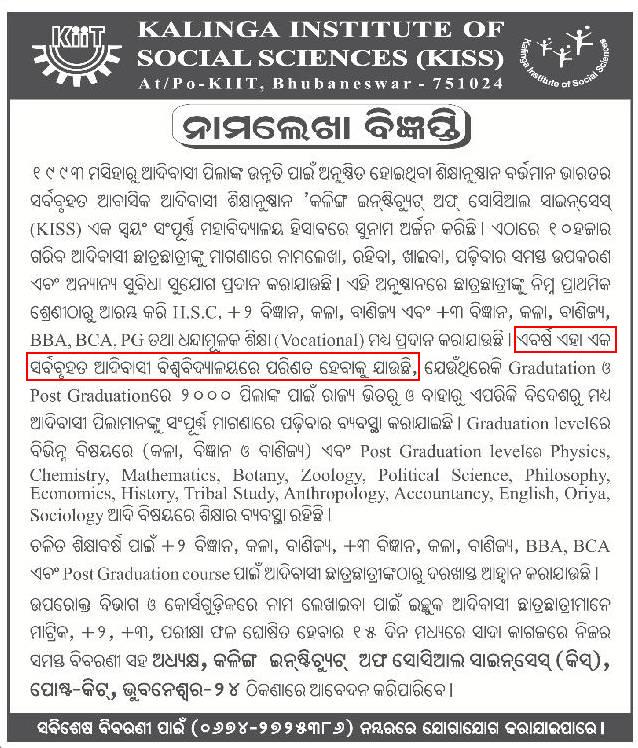
Considering the way KIIT is going one day the group may have the maximum number and variety of programs among all universities in India. Below are a list of programs at the Bachelors/Masters level that come to mind that the KIIT group does not yet have. Readers are requested to suggest additional programs.
- School of Architecture
- School of Physical and Earth Sciences (Mathematics, Statistics, Physics, Chemistry, Geology, Earth Science)
- School of Life Sciences (Biology)
- Schoolof Liberal Arts (Economics, Political science, Geography, Philosophy, Sociology, Anthropology, History, Linguistics, Psychology, Sociology, Women and Gender studies)
- School of Public Health
- School of Archaeology
- School of performance arts (Music, Dance, Theater, various instruments, various kinds of vocals) – with regular events for locals
- School of Fine Arts and Creative Writing (Art education, Art history, Art studies, ceramics, drawing, fibres, metals, painting, photography, print making)
- School of Business (Accountancy, Finance, Entrepreneurship, Marketing)
- Additional Engineering fields: Industrial engineering, Chemical engineering, Bioengineering, Petroleum Engineering, Mining Engineering, Metallurgical Engineering, Biomedical Engineering, Environmental Engineering, Aerospace Engineering
- Culinary Institute
- School of Public Policy and Government
- School of Energy and Sustainability
- School of Construction
- School of Medical technology (including Bio-Medical Informatics)
- School of Nursing
- Programs in Social Service
- School of Agriculture
- School of Veterinary Science
- School of Education (including special education)
- School of Agri-business, Food science and Nutrition
- School of Tourism
- School of Sports sciences and Kinesiology
- School of Religious studies
- School of Aviation and Aviation management
June 7th, 2009
Update: Hindu also reports on it. In regards to the location of the permanent campus, Hindu says the following:
While speaking very high about the proposed location for establishing the university which is situated between the railway station at Koraput and Danagadeola village over an area of 565 acres of government land she said that over the next five years the university could become one of the major attractions even for the tourists for its unique green campus resembling that of many world class university campuses in the other parts of the globe.
Following is an excerpt from a report in the Pioneer.
Vice-Chancellor of the Central University, Orissa, Dr Surabhi Banerjee informed that the classes in the university at Koraput would start from August this year. The university would function temporarily at the COATS (Council of Analytical Tribal Studies) and the courses would start from under-graduation to higher studies, she said.
…, the VC visited Deola village where the proposed university will be set up over 575 acres of land. … She thanked the district administration to locate such a suitable land and … After visit of the representatives from the Ministry of Human Resource Development, the construction work would be carried out on their approval, she said.
There will be an entrance test for taking admission into the university and the entrance test would be conducted in around 15-16 centres all over India and for Orissa in Koraput, Bhubaneswar and Sambalpur. Subjects like English, Oriya, Social Sciences, Anthropology, Tribal Studies and Journalism and Mass Communication would be taught in the university, besides other higher and professional courses. Different kinds of schools will be opened on the campus like the Jawaharlal Nehru University and the head office of the university would function at Koraput and the transit office to recruit lecturers, readers, professors, management and other staff will function at Bhubaneswar, the VC informed.
The Central Government has approved the university for five years for the time being and the classes would start in the COATS which is being managed by Sabara Srikshetra Jagannath Mandir Management Committee and the existing Gyan Mandir, library and tribal museum are an added advantage for the students of the university, she said.
Among others, Registrar BK Mishra, Financial Advisor P Pati and Liaisoning Officer and Coordinator Ganesh Chandra Roul attended the Press conference.
May 25th, 2009
